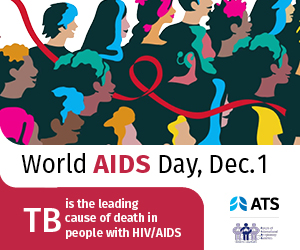NEW YORK, NY – Nov. 27, 2024 –The latest World Health Organization’s Global Tuberculosis Report released in November 2024 painted a sobering picture; approximately 8.2 million people were newly diagnosed with TB in 2023, the highest number since the organization began global TB monitoring in 1995. TB is the leading cause of death among those with HIV /AIDS worldwide. According to the WHO, in 2023, 161,000 people died of HIV-associated TB.
This World AIDS Day, Dec. 1, the American Thoracic Society and our Forum of International Respiratory Societies (FIRS) partners call on governments, health advocates, and non-government organizations to strengthen their response to AIDS and TB. This collaborative effort is necessary to help realize the World Health Organization’s goal of ending the AIDS epidemic by 2030.
“Multidrug-resistant TB remains a public health crisis,” said ATS President Irina Petrache, MD, ATSF. “According to the WHO, while an estimated 400,000 people developed multidrug-resistant or rifampicin-resistant TB (MDR/RR-TB), only 44 percent were diagnosed and treated in 2023. The ATS will continue to advocate for global and domestic funding for TB research, including new TB vaccines.”
ATS began in 1905 as the National Association for the Study and Prevention of Tuberculosis. Today, the ATS and other FIRS members, representing the world’s leading respiratory societies, are working to improve lung health globally.
In the developing world, TB is often the first sign a person has HIV. Yet, about half of the people living with HIV and tuberculosis are unaware of their co-infection and, therefore, not receiving appropriate care that could prevent not only serious illness but death, according to WHO.
Shortly after AIDS emerged, it fueled a global resurgence of TB that continues in many low- and middle-income countries. The WHO African Region has the highest burden of HIV-associated TB. People living with HIV are 16 times more likely to fall ill with TB compared to people without HIV.
HIV increases the risk of other infectious respiratory diseases, including Pneumocystis jirovecii pneumonia and bacterial pneumonia, both of which can be life threatening.
Education, prevention strategies, and new medicines, particularly antiretroviral therapies, have reduced the number of AIDS-related deaths by 69 percent since the peak in 2004.
FIRS believes a global response to HIV/AIDS can be strengthened by:
- Increasing awareness of the continuing global threat of HIV-related disease and its link to TB and other respiratory diseases.
- Improving the health outcomes of people living with HIV through patient care and research into better prevention, early diagnosis, and effective treatment strategies for both HIV and TB, including rapid diagnosis and treatment for multidrug-resistant TB that is harder to cure.
- Reducing the incidence and severity of HIV-related disease by strengthening mother-to-child transmission prevention programs and increasing the early use of antiretroviral therapy.
- Improving HIV education in at-risk communities to reduce the incidence of new HIV infections.
- Reducing HIV-related health disparities and inequities.
Contact for Media:
Dacia Morris, American Thoracic Society Director, dmorris@thoracic.org
